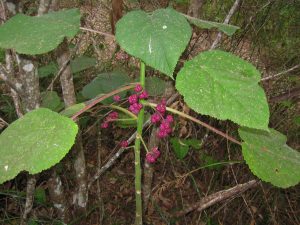Gympi Gympi (Dendrocnide moroides)
The Gympi Gympi is also known as the Stinging Tree, and is said to be one of the world’s most venomous plants. Those unlucky enough to have suffered a major sting claim the pain is the most excruciating of any they have endured.

World-wide there are 37 species of stinging tree with 6 in Australia. The Dendrocnide moroides has the worst sting. The tree is often described as a shrub but can grow to a height of 4 to 5 meters. It tends to grow in open, disturbed sites such as a cyclone damaged area or in a clearing where a tree has fallen. They like sunny, but sheltered areas and are often found along walking tracks or the edges of streams. The Gympi Gympi is found from Gympie in Southern Queensland to Cape York Peninsular and is very common in the Atherton Tablelands. It is generally not common along any of the Paluma walking tracks that have a complete rainforest canopy, but small plants can spring up quite rapidly in damaged areas exposed to sunlight.
The leaves of the Gympi Gympi, carried on long, hairy stalks are finely serrated and heart-shaped. They are covered in fine stinging hairs which give the leaves a furry appearance. The fine silica hairs break off when touched and embed in the skin. They act like syringes and continue to inject venom for several days. Even dead leaves are capable of inflicting a sting. The pain experience depends on the amount of contact with the leaves but also varies between people. A brief brush with a leaf can lead to significant but bearable localized (surface) pain, but extensive contact (especially in sensitive areas of thin skin) can be excruciating, often with extreme reactions like swelling and profuse sweating. The pain reduces over time but can linger for over a month. Rubbing the skin exacerbates the situation as it breaks the hairs, leaving the points embedded in the skin. Also, contact with cool water leads to recurrence of pain days or weeks after the event. Unfortunately for those stung, there is no truly effective treatment although shaving the affected area and then daubing it with a weak solution of hydrochloric acid or full strength house-hold vinegar can help to alleviate the worst of the pain. This treatment is only for the strong-minded since it causes the pain to significantly increase for several minutes before acting to reduce it.
The chemicals contained in the venom are not completely understood but it is suggested that a peptide called moroidin could be responsible for the pain. Some birds, mammals and insects appear to be immune to the venom as many eat the fruit and leaves without harm. The fruit is edible to humans brave enough to sample them and are quite pleasant in flavor – just be careful not to touch the leaves or stem when picking the berries!
The fruit of the Gympi Gympi is actually a small nut enclosed within a fleshy sac. Several sacs are clustered together to form a mulberry-like fruit which hangs from a stem. The stems and fruit are also covered in fine hair.
